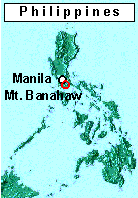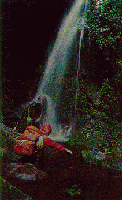Guides - Mt. Banahaw, Central Luzon
THE GUSHING SPRINGS OF MT. BANAHAW
 About 170-km southeast of Manila rises the majestic 2,188-meter MOUNT BANAHAW,
a national park, located near Dolores, Quezon Province. This extinct volcano
is also known as "vulcan de aqua" because of numerous springs that
flow from the base.
About 170-km southeast of Manila rises the majestic 2,188-meter MOUNT BANAHAW,
a national park, located near Dolores, Quezon Province. This extinct volcano
is also known as "vulcan de aqua" because of numerous springs that
flow from the base.
Geographer Fr. Huerta mentions in Estado Geographica
that the crater used to be occupied by a lake until 1730 when an eruption
burst open the southern rim and let the water and lava flow out.
Considered a sacred mountain by the local residents, Mt.
Banahaw teems with legends and superstitions. Seventeen religious sects
with different beliefs and rituals endow it with mysticism. A clear blending
of Filipino religious fanaticism and superstitious beliefs is evident.
Jump-off point is Sta. Lucia towards Kinabuhayan town.
The wide and well-trodden trail leads to Kristalino Falls (Crystalline
Falls), a 30-m waterfall surrounded by vine-covered trees, ferns, palms
and bamboos. Just one-and-a-half hours away is a second waterfall whose
surrounding area is ideal for a campsite.
One of the most difficult portions of the trail is a vertical
wall leading to a very narrow ridge over a minute waterfall, known as Salamin
Bubog (Glass Mirror), the waters of which lie as still as a mirror. This
is climaxed by a treacherous slippery stretch over huge boulders leading
to a cavernous formation with a 30-m high entrance: Kuweba ng Dios Ama
(Cave of God the Father).
Local folks admonish visitors to approach the cave with
respect and solemnity lest sudden storms accompanied by thunder and lightning
be leased out upon such "irreverent" persons.
 On the way to
the summit are the following landmarks: Pintong Lihim (Hidden Door); huge,
moss-covered boulders marking two divergent paths; and rows of trees with
bent, twisted trunks almost hugging the ground on bent knees, commonly
known as Niluhuran (place where trees knelt). On the way to
the summit are the following landmarks: Pintong Lihim (Hidden Door); huge,
moss-covered boulders marking two divergent paths; and rows of trees with
bent, twisted trunks almost hugging the ground on bent knees, commonly
known as Niluhuran (place where trees knelt).
The first peak is finally reached: Santong Durungawan (Holy
Window), overlooking a clear, blue, open sky.
A trip down the crater of the extinct Mt. Banahaw entails
another day of trekking through forested areas. Although the pilgrim trail
passes through steep inclines, it is clearly marked with roots and shrubs
which serve as good footholds.
Spots along the the way are: Kuwebang Usa (Deer Cave) and
Katedral (Cathedral), a semi-circular piece of level ground surrounded
by tall trees.
Along the eastern side of the crater stands a wall of vegetation
in the vicinity of which can be found two distinct water courses: Tubig
ng Gatas (Milk Water) and Tubig ng Dugo (Blood Water). These are two springs
running down two mineral veins tracing a serpentine path from the top to
the bottom of the pit. One is as white as marble and the other as red as
iron.
The crater is shaped into a winding canyon with walls soaring
as high as 915-m. Its floor is between 27 to 46-m wide. Thick forests carpet
most of the interior but some portions exhibit marked scars of past avalanches.
At the farthest end of the zigzagging corridor stands the
north wall with a magnificent waterfall plunging 152-m down the rocky facade.
Prior to reaching this point, however, a very rugged terrain strewn with
massive boulders has to be traversed.
 Typical Four-Day
Schedule Typical Four-Day
Schedule
DAY 1
0700 Breakfast. Check equipment and supplies.
0800 Leave Manila for San Pablo, Laguna via public bus or hired
vehicle.
1000 Arrive at San Pablo. Proceed to Santa Lucia by public jeepney.
1030 In Santa Lucia, contact National Parks Station for a guide.
1100 Hike to Kinabuhayan.
1230 Take lunch at Kinabuhayan.
1330 Begin climb.
1400 Reach first waterfall: Kristalino Falls.
1530 Arrive at second waterfall. Rest and find suitable spot to
set up camp. Enjoy the scenery and the cool, refreshing water.
1700 Early dinner with the soothing sounds of the falls in the
background.
DAY 2
0700 Breakfast. Pack up and remove all debris from campsite prior
to continuation of ascent.
0800 Climb up vertical wall. Find way over narrow ridge, under
which is a small waterfall referred to as Salamin Bubog (Glass Mirror).
0900 Reach detour and backtrack slightly to locate trail.
0920 Traverse a treacherous, slippery gully to a natural cave known
as Kuweba ng Dios Ama (Cave of God the Father).
1030 In the cave, take a brief rest and snacks.
1100 Climb rock formation with 45-degree gradient. There are hardly
any handholds due to the absence of any plants or trees. Climbers can rely
solely on cracks along the surface. At the base is a deep gully. Good luck!
1130 Arrive at top marked with tall grass and trees. Encounter
diverging paths. Always follow one going to the right.
1200 Lunch along the way.
1300 Resume climb.
1430 Reach Pintong Lihim (Secret Door). Proceed to the summit.
Come across bent twisted trees. Residents of the area call this particular
spot Niluhuran (place where they knelt).
1900 Arrive at the peak: Santong Durungawan (Holy Window). Establish
camp and take dinner.
DAY 3
0700 Breakfast. Break camp. Take photos if weather permits.
0800 Start descent.
1300 Reach Tatlong Tangke (Three Tanks). This term refers to a
series of waterfalls. Have lunch.
1400 Resume hike down. Pass through a gully and over the kaingin
(slash-and-burn farming) trail.
1600 Cross over rocky trail which leads to the "backyard" of the
town of Kinabuhayan.
1630 At Kinabuhayan, inform Barrio Captain about arrival. Find
suitable place to stay overnight. Mingle with townsfolk to get first-hand
experience about life and customs in a typical Filipino barrio.
DAY 4
0700 Breakfast.
0800 Return to Manila.
Special Considerations
-
Always contact local weather station for the latest conditions within the
vicinity of the climb.
-
It is possible to attempt the climb anytime of the year in absence of tropical
depressions or if advised otherwise by the local weather bureau.
-
Guard against leeches especially during the rainy season. Secure cuffs
of long-sleeved t-shirts and pants. Tweezers and lighted cigarettes are
useful for removing leeches. As a preventive measure, ordinary
soap may be rubbed on pants and shoes to ward off leeches.
See Also:
Take me back to Bundok's Guides Page |

